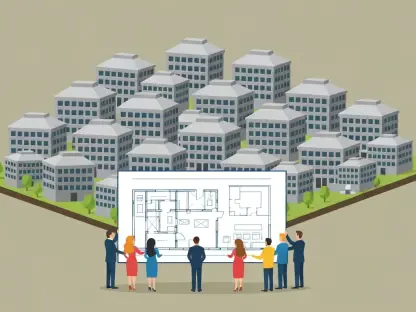In the current landscape, the housing market stands at the crossroads of numerous challenges, one of which is an upward trajectory of labor costs in construction. This surge is primarily fueled by rising wages among unskilled workers, significantly impacting overall construction expenses and subsequently driving home prices higher. A study conducted by experts in the field scrutinized wage trends across 20 construction occupations from 1999, demonstrating a marked increase for unskilled labor versus skilled professions like electricians and engineers. Unskilled laborers, performing foundational tasks such as trench digging and concrete mixing, have seen wage growth ranging from 2.75% to 3.5% annually, starkly outpacing their skilled counterparts. The labor shortage compounds this scenario, as the pool of unskilled workers has halved from figures reported over two decades ago, further complicating the dynamics within construction firms.
The Ripple Effect on the Construction Industry
Wage Dynamics in Construction
These wage increases don’t occur in isolation but trigger a domino effect throughout the industry. Unskilled laborers typically engage at the onset of construction projects, and their escalating costs inevitably influence subsequent stages of building efforts. With many contractors closely monitoring these trends, it becomes clear that elevated early-stage labor expenses can presage broader industry-wide salary hikes. These dynamics pose significant budgeting and project management challenges, urging industry stakeholders to adopt adaptive strategies. An industry now grappling with adverse impacts stemming from external factors—such as the COVID-19 pandemic, geopolitical tensions like the Russia-Ukraine war, and disruptions in global supply chains—must carefully consider how to address these rising costs. The ability to effectively navigate these murky waters hinges on having access to accurate market data and leveraging current trends to devise innovative solutions.
External Influences on Labor Costs
Recent years have not been kind to the construction sector worldwide. The upheavals brought on by COVID-19, paired with supply chain disruptions and economic sanctions such as those involving steel and aluminum tariffs, continue to exert pressure on these already strained dynamics. A sizable percentage of firms report difficulties acquiring both labor and materials fundamental to operations, and broader geopolitical issues threaten to exacerbate an already tight labor market. This scenario calls for heightened vigilance among industry players, aiming to forecast flexibly and accurately what lies ahead. Tracking market data and emerging trends has never been more critical. Companies are increasingly called to develop responsive strategies, ensuring they stay ahead rather than stagnant in an evolving landscape marked by uncertainty and flux.
Navigating the New Labor Cost Landscape
Strategic Planning Amidst Uncertainty
In navigating this complex environment, foresight and precision in planning become indispensable tools. Labor cost predictions and strategic adaptations must align with the realities of the current market, incorporating responsive, innovative solutions to these ongoing challenges. Innovative collaborations such as the Missouri Consortium for Construction Innovation exemplify efforts to address key issues, including material costs and cross-border trade concerns. Stakeholders are continually on the lookout for initiatives such as these to guide through the intricacies of today’s market dynamics. Understanding and preparing for surges in costs, alongside innovative alliances and adaptations, situate companies in a position to thrive despite adversities faced. Implementing a proactive approach helps mitigate risks tied to unforeseen challenges and harnesses opportunities that arise amid disruption.
Collaborative Solutions for Future Growth
In the face of unrelenting pressure, it’s increasingly clear that industry stakeholders must band together in search of long-term solutions. Collaborative efforts help resolve matters that individual players might find overwhelming alone, such as surges in material prices and navigating international trade dynamics. Organizations such as the Missouri Consortium for Construction Innovation serve as beacons within the industry, offering frameworks for companies large and small to tackle these persistent obstacles collectively. Focused on collaboration and targeted solutions, these initiatives lead the way toward innovation and success amid a landscape characterized by change and uncertainty. The importance of collaborative efforts becomes paramount, not only to sustain operations but to drive growth and efficiency throughout the building sector.
Future Considerations for the Housing Market
As the housing market continues to evolve under the weight of rising labor costs, stakeholders will need to focus on actionable strategies to mitigate the impact. Moving forward, construction firms must consider adopting innovative pricing models and investing in technologies that enhance labor efficiencies. These measures can significantly offset rising costs and help maintain affordability in housing prices. Strengthening partnerships and collaborative efforts will also play a crucial role in navigating this challenging terrain, allowing firms to pool resources and insights necessary for long-term success. As the industry adapts to new realities, pioneering methods to optimize labor and resource management become central to preserving competitive advantages. With informed foresight and strategic planning, industry players can manage risks effectively and capitalize on opportunities that arise amidst shifting market conditions.









